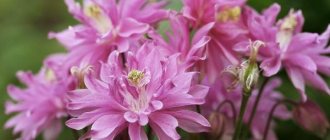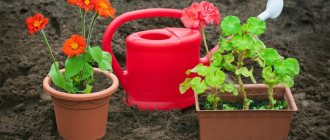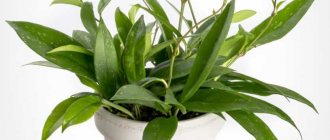Every housewife dreams of seeing her garden plot blooming and fragrant. For this, a lot of effort and time is spent, a combination of different plants is selected, and flower beds are erected. But it is impossible to imagine a single flower bed without a beautiful and delicate eustoma flower. In addition to growing in open ground, this plant looks great in a flower pot on the windowsill.
If the reader has never heard or seen this beautiful flower, then the editors of the Agronom.guru portal will help you understand the question of how to properly plant perennial eustoma and tell you about further care. The article will also present photos of buds and flowers that amaze with their beauty.
An ideal solution for decorating a personal plot
Types of Irish rose eustoma - brief botanical information
Perennial eustoma is a delicate and luxurious flower that came to our country from Central and South America and immediately won the hearts of many gardeners. In nature, only blue and purple flowers exist, but thanks to the efforts of breeders, varieties of various shapes and colors have been developed.
The flower is original not only for its beauty, but also for its various names. In each country, the plant has its own name: in Ireland - Irish rose, in Japan - Japanese, in France - French love rose, and in Ireland - Irish rose or Texas bluebell. Eustoma is also called lisianthus, which means “bitter flower” in Latin. The flower received its second name for a reason, since it belongs to the Gentian family and contains a large amount of gentianin, genceopecrin and genteamarin. All these poetic names are true and show the love of many countries for this amazing and unusual perennial.
Lisianthus and eustoma are the same plant
What does eustoma look like and where does it grow?
Eustoma (from the Latin name - “Eustoma”) has many other names. People call it herbal, Irish, Japanese, French or Chinese rose (not to be confused with hibiscus), and in the USA the plant is nicknamed “Texas bell.”
The flower has strong stems, in most species growing to a height of 1 m. Approximately 50 cm from the ground they begin to branch. Moreover, over 30 buds are often formed on each shoot during flowering. They bloom not at one moment, but one after another, so the Texas rose is decorated with beautiful flowers for a long time and is very attractive.
Looking at the leaves of eustoma, it seems that they are made of wax. This impression is largely due to their bluish color and matte surface. The flowers are large, 5–8 cm in diameter, funnel-shaped. In decorative floriculture, double plant species are more often used, although there are also non-double ones. Their color can be different: white, pink, lilac, plain or with a border. When the flower opens halfway, it looks very much like a garden rose. Later it takes on a resemblance to a double poppy.
Lisianthus grows wild in the Southern Hemisphere: in the southern territories of North America, including Mexico, in the northern part of South America and on the islands located in the Caribbean Sea. It prefers to settle in river valleys, where it receives enough moisture.
Photo of a rose-like eustoma flower in a garden and bouquet
Irish rose can be grown at home on the windowsill and in the garden. This plant looks great as a cut flower because of its beautiful flowers, which resemble half-opened silky roses. Flowers can stand in water for a long time without losing their beauty.
Photo of flowers in the garden
What eustoma looks like in bouquets, photo
Description
A perennial plant, which can be annual in cold climates, it has large flowers of various shades - from white to multi-colored. They resemble a half-opened rosebud, but the stems of eustoma do not have thorns. They reach a height of no more than 50 centimeters. However, due to the extensive branching, one branch can look like a bouquet. Lisianthus leaves are matte with a bluish tint and a waxy texture. For planting in pots and growing indoors, dwarf varieties are used that are no more than 30 centimeters in height. One plant bush can have up to 35 buds.
Open ground or pot - where is it better to grow eustoma
Most gardeners wonder where it is better to grow perennial eustoma - in the garden or in the apartment? The answer is obvious that no matter where this flower grows, it will always delight its caring owner with its beautiful appearance. When grown in the garden, the plant will decorate any flower garden, will be an addition to rock gardens, and will also look beautiful in single plantings.
The most common is eustoma grandiflora.
Although eustoma is considered an annual plant when grown at home, it will, without any doubt, be one of your favorite indoor flowers, even though it must be grown from seeds every year. If you want to admire beautiful flowers on cold, short days, sow the seeds in mid-summer.
Eustoma prefers bright, diffused light
Popular types and varieties of eustoma
Botany knows about 60 plant species. Two of them are used in floriculture: eustoma grandiflora and Russell. Moreover, some scientists believe that this is the same species.
Mostly tall varieties are used for growing in the garden. They look good in flower beds and as cut flowers. The height of the stems is more than 70 cm:
- Aurora: reaches 90–120 cm, and the main advantage of the variety is its early flowering - it occurs 3 weeks earlier than the others;
- Echo: much lower - the height of the stems is only 70 cm, but they branch strongly and form a spreading bush, and the color of the flowers can be very diverse, including two-tone.
How to plant eustoma seedlings
Growing eustoma from seeds will not be difficult even for a novice gardener. You just need to know when and how to plant seeds for seedlings. Since properly grown seedlings are the key to a strong and healthy plant.
When to plant eustoma when growing from seeds
Eustoma is a slow-growing plant that, when grown from seeds, will bloom only at 25 weeks. Therefore, in order to see the long-awaited flowering, the seeds are sown in mid-December or early January. Many gardeners carry out this procedure in early November.
Since the seeds have good germination, they do not need stratification
How to sow eustoma seeds for seedlings at home: step-by-step instructions
| Photo | Action |
| In order for the plant to delight with its flowering for many years, it is necessary to approach the choice of seeds with all responsibility. You need to buy them only from trusted manufacturers and in yeasted form. | |
| Before sowing, prepare nutritious, well-drained soil. For good ventilation of the seedlings, it is better to sow the seed in shallow furrows. We place the seeds in spilled soil, dig them a little deeper and install a microgreenhouse to create favorable conditions for rapid germination. | |
| If you follow the sowing rules, the first seedlings will appear in 2.5 months. All this time, the plant is growing a powerful root system, which has a positive effect on the growth of an adult plant. | |
| Picking is carried out at the stage of 2-3 true leaves into prepared nutrient soil. | |
| We water the seedlings well and put them in a warm, sunny place. We carry out the first feeding after 5-7 days with calcium nitrate, diluted strictly according to the instructions. Next, careful care of the young plant is necessary. |
Step-by-step instructions on how to grow eustoma from seeds
Growing lisianthus from seeds is a rather painstaking process that requires a lot of attention from the grower. To grow eustoma flowers from seeds yourself, you need to follow the following instructions.
- To perform this procedure, you will need a plastic tray and a metal grill with small windows. The size of the grid should ensure that the peat tablets are kept above the water.
- Initially, you need to pour water into the pan with the addition of a growth stimulator. You will also need to add other fertilizers, in particular nitrogen. It is recommended to add soil disinfectants to the water.
- Next, a grid with peat tablets is installed above the pan. They should barely touch the surface of the water. In this case, the tablets need to be spaced from each other at a distance of 5 centimeters. This will avoid fungal infection between seedlings.
- After the tablets swell from moisture, you need to place eustoma seeds in them. 3 seeds are planted in each peat tablet.
- The first shoots will appear 2 weeks after planting. At this time, you need to select the most developed and strong shoots. All sick and weak ones should be removed.
- It is important to place the tray with the trellis and plants in a warm room with moderate diffused lighting. The top of the tray is covered with glass or film to create optimal humidity conditions.
- It is necessary to ventilate the seedlings daily, without temperature changes or drafts. If the peat tablets dry out, it is recommended to carry out additional watering.
- After 5.6 leaves appear on the young plants, the cover can be removed from the tray.
- Next, transplant the eustoma along with the peat tablet into its own flowerpot. The transplantation process should be carried out in the evening.
eustoma seedlings
How to properly care for seedlings
In order for the plant to be strong and healthy, it is necessary to properly care for the seedlings. Maintain temperature and humidity conditions, carry out regular spraying and fertilize with complex mineral fertilizers every 10 days.
Properly grown seedlings are the key to long and beautiful flowering
Lighting, temperature and watering
After picking, seedlings require careful care:
- For good growth of eustoma, you need to create moderate warmth, daytime temperature - +20..+25°C, night temperature - not lower than +20°C.
- Eustoma is a light-loving plant. For rapid development, young seedlings need a lot of diffused light. Therefore, it is better to grow them on the western or eastern side. In winter, additional artificial lighting is installed.
- Watering is the most important stage in care. Since the plant does not tolerate both underwatering and overwatering. The soil in the pot should always be kept moist. The water should be soft, settled and not very cold. The flower will be grateful if it is watered with melt or rain water. Such water contains the necessary microelements for good growth and development. In winter, if the flower grows in an apartment, watering is reduced and the humidity is increased using a humidifier or a container of water.
- During the period of active growth, eustoma requires replenishment with mineral fertilizers in a slightly lower dosage than described in the instructions. With enough nutrients, growth will be faster, and flowering will be abundant and long-lasting.
Caring for a young plant will require a lot of effort and patience.
When and how to pick eustoma
Picking is carried out at the age of 6-8 weeks. To do this, prepare separate containers with nutritious, well-drained soil. The seedlings are carefully removed, trying not to damage the root system, and transplanted into separate containers with a diameter of 5 cm. During this period, the plant is regularly watered and fed once every 10 days.
The second picking is carried out after 30 days, when the plant gets stronger and grows green mass. You need to replant the plant to a permanent place, be it open ground or a flower pot, together with a lump of earth. The transplanted plant is watered and shaded from sunlight for 2-3 days.
You can learn how to properly dive eustoma from the video:
Picking is carried out at the age of 3 months
Growing eustoma: features
When breeding eustoma, it is important to consider many important factors.
This plant is a lover of bright, diffused light; the best soil for it would be mixed peat with bark humus.
For those who are attracted to this “beauty”, it is important to remember that it reproduces only with the help of seeds, but watering is necessary when the soil has dried at least 2 cm deep. It is not recommended to replant plants, because the roots are relatively weak and therefore are not able to adapt to new conditions. The best conditions for the plant will be a cool room with good air circulation.
Varieties and hybrids
At the moment, there are more than 60 varieties of eustoma. Lisianthus species are divided into low-growing ones, which are good for growing indoors, and tall ones, for decorating the garden. The flowers of the plant can be double and simple and have a wide variety of colors.
Garden eustoma includes the following species:
- Aurora;
- Echo;
- Heidi;
- Flamenko and others.
Indoor eustoma includes low-growing varieties - Mermaid, little Bell, Florida pink, etc. Today, not only professionals, but also amateur florists can grow it.
Lisianthus - lover of bright light
Lisianthus from seeds
Growing lisianthus at home is a difficult task that requires a lot of time and effort, and perhaps patience. However, if you master all the intricacies of this process, the result can exceed all expectations. Due to the fact that the “Irish rose” is gaining great popularity among gardeners and amateur florists, growing and caring for it can bring considerable profit and satisfy an aesthetic need. The big problem is that eustoma seeds are quite small in size (1 g = 23,000 seeds), out of a hundred seeds sown, 60 will sprout.
Growing eustoma in the garden
If you want to see the “Irish rose” blooming in the garden already in the middle of summer, then it is better to sow eustoma in late winter - early spring . The soil should be sterilized and contain a small amount of nitrogen. Having scattered the seeds into the desired container, just press them lightly and cover them with polyethylene or glass on top so that there is free access to oxygen; additional light supply is desirable; it can be organized using fluorescent lamps 10-12 hours a day. The optimal air temperature should range from +14 ºC at night to +20 ºC during the day. The future plant will not need watering in the next 2 months due to the moisture received from evaporation; in the future, you can lightly spray the seeds. The results of the first shoots will be seen in a couple of weeks, after which it is necessary to remove the glass and regularly spray the shoots with a phytosporin solution. After the first pairs of leaves appear, you can immediately transplant them into larger containers. After three months, future plants can be transplanted into open ground along with a lump of earth.
We also recommend reading
- How to make a flower garden from continuous flowering perennials?
- Wooden lattice for gazebo
Indoor eustoma from seeds
In order for eustoma to be a wonderful decoration for your apartment in winter, you need to sow it at the end of summer. To do this, you need to fill a small pot or other container with moistened soil, which contains sand and peat in equal proportions, and scatter the seeds on top of it. Next, according to the same scheme: cover the top with polyethylene or glass to allow light to penetrate and place it in a place where there will be a sufficient amount of heat and light. If necessary, spray and after three weeks the results will be obvious.
Growing at home
Lisianthus seedlings
When the first leaves appear, you can reduce the amount of moisture by allowing the top layer of soil to dry out a little. After this, it is worth watering, but it should be done in the morning so that by evening the leaves remain dry. When the sprouts produce two pairs of leaves, you can transplant them into separate containers and wait for flowering, which will come in the middle of winter.
Eustoma seedlings
Lisianthus care
In order to grow this plant at home in a pot, it is important to remember that it should not lack bright, diffused light and oxygen. Therefore, it is worth choosing a place where it would be possible to maintain the desired temperature and have access to constant ventilation, for example, a window facing west or east. When watering, it is important to remember the “golden mean” so as not to overdo it in waterlogging or deep drying, although light drying of the top layer is quite appropriate. Water for irrigation should be settled and soft. There is no need to spray the plant to avoid leaf diseases, but it is worth fertilizing during intensive growth and bud formation.
Compliance with the necessary conditions is the key to repeated flowering.
Terry eustoma
Growing eustoma garden
Eustoma for the garden is grown from seeds, sowing at the beginning of winter (December, January), so that the flower blooms by summer. For sowing, you can use small cups and soil, as for violets. The seeds are laid out on top, 5 pieces at a time, and covered with film, creating a greenhouse effect. Every time, every ten days, it is necessary to lift the cover to allow fresh air to penetrate and remove excess moisture resulting from evaporation. It is important to remember the mandatory conditions - the optimal temperature is not lower than +20 degrees and a sufficient amount of daylight. At the end of winter, the seedlings can be placed on the windowsill to bask in the rays of the almost spring sun.
Garden eustoma can also be grown using seedlings. This should be done in the month of May, when the likelihood of frost is minimal.
The chosen location requires good diffused light and protection from drafts. It is better to plant in the evening or when it is cloudy outside, in a small hole that has been previously moistened. The seedling is placed in a hole along with the soil in which it grew. The distance between the units is 10-15 cm. After planting, you can cover the seedlings with glass jars and do not water them; moisture will be due to condensation. When at least 6 leaves appear on the stem, it is recommended to pinch the top so that the young plant can branch better.
How to grow eustoma at home (video)
Eustoma after flowering
If this is an indoor eustoma, then after flowering it needs to trim the stem so that 2-3 internodes remain. During the dormant period, it can be stored in a room where the temperature is about 15 degrees above zero; it needs to be watered very rarely; there is no need for fertilizing at all. When new shoots appear, the plant is transplanted into a new substrate and normal care is resumed.
If we are talking about garden lisianthus, then its flowering can be extended by transplanting it into a pot and moving it to the territory of a balcony or window sill. At home, the flower will be able to survive for some time, but dormancy is no exception for it. During this period, caring for the plant is no different from caring for indoor eustoma.
Planting seedlings in open ground
The young plant is planted in mid-May, when the threat of spring frosts has passed.
If the flower has produced 6-8 leaves, it means it is ready for replanting.
Before planting seedlings in open ground, you need to find a place and prepare the soil. A place for planting is suitable with light partial shade, since a flower in the open sun can get burns on the leaves. Also, do not plant in a place where water accumulates. This leads to rotting of the root system and death of the plant.
For good growth and long flowering, eustoma is planted in well-drained sandy loam or loamy soil with neutral acidity. For planting, dig a hole, lay drainage and mineral fertilizer. The young plant is removed from the pot by transshipment and placed in a prepared place. When planting, do not deepen or expose the root collar. The planted plant is thoroughly watered, and the ground is mulched with straw or freshly cut grass to retain moisture.
The distance between the holes must be at least 40 cm from each other.
Caring for eustoma in the garden
Caring for the flower is simple. The main thing is to water and feed the plant on time. During active growth, the soil around the plant is regularly loosened and kept moist. To do this, the ground is mulched with straw, leaves or bark.
During flowering, mineral complex fertilizers with a high potassium content are applied. Tall varieties are provided with a support that will protect them from gusty winds and from the pressure created by a large number of buds and flowers. For long-term flowering, it is necessary to promptly remove dried inflorescences so that the plant does not waste energy on ripening the seeds.
What could be more beautiful than eustoma growing in the garden?
Preparing for winter
When the Irish rose fades, it is necessary to prepare for wintering. In regions with warm winters, the flower can overwinter in open ground. If winters are harsh and snowy, then the plant is dug up, transplanted into a pot and taken to a room where the air temperature does not drop below +15°C. If the temperature is too high, the leaves of the lisianthus will turn yellow, and over time the plant will dry out completely.
Low temperatures also have a detrimental effect on the flower. In winter, most plants enter a dormant period, during which time they accumulate strength for future growth and flowering. During the hibernation period, the plant requires proper care. Watering is kept to a minimum, making sure that the soil is kept moist. In spring, the awakening of the plant can be recognized by the appearance of new young leaves. As soon as the temperature stabilizes, the bush is planted in its original place and awaits the long-awaited flowering.
At the slightest frost, lisianthus dies
Growing potted eustoma: care at home
In order for the Irish rose to develop well, it is necessary to create favorable conditions in the apartment. Let's get acquainted with some of the nuances of growing this plant.
An adult flower can grow to a significant size and will need to be moved to a new larger container. Eustoma does not like transplants, so the procedure must be carried out with special care. The plants are transferred from pot to pot, filled with new nutrient substrate and watered with warm water.
Caring for lisianthus in apartment conditions involves timely pruning and feeding of plants, maintaining the necessary air and soil humidity. Let's take a closer look at these procedures.
Caring for eustoma at home when planting in a pot: step-by-step instructions with photos
| Photo | Action |
| In order for the Irish rose to decorate your apartment, you can sow the seeds yourself or purchase an already mature seedling. | |
| For a plant to grow and develop well, it needs bright, diffused light. On the south side it is shaded from direct sunlight. In summer, the flower is taken out into the open air, be it a loggia or a personal plot. In the autumn-winter period, additional lighting is necessary. | |
| The air temperature in summer should not fall below +20°C. With the onset of autumn, the temperature decreases. If the flower is grown as a perennial, it is necessary to provide it with a dormant period in winter. The temperature at this time should not rise above +15°C and not fall below +10°C. | |
| Humidity also plays an important role. When the air is dry, the plant will shed its leaves. A humidifier is installed to increase the air. Spraying is strictly prohibited, as too high humidity leads to fungal diseases. | |
| Water once every 7 days as the soil dries out. The water that forms in the pan is removed immediately, as this can lead to rotting of the root system. | |
| During the period of active growth and flowering, the Irish rose is fed with mineral fertilizers every 10 days. | |
| If eustoma is grown as an annual, it does not need to be replanted. If it is a perennial, transplantation is carried out using the transshipment method. | |
| For long-term flowering, faded stems are removed, leaving at least two pairs of leaves. New shoots will grow from these stems over time. | |
| To prevent the development of fungal diseases, the plant should not be allowed to overcool. If you follow these simple rules of care, eustoma will become your favorite indoor plant, which will delight its owner with abundant and beautiful flowering. |
Eustoma perennial, planting and caring for seedlings
Growing eustoma requires effort from the grower. This is a heat-loving plant that will grow and bloom well only under favorable conditions.
How to prolong the flowering of eustoma
For propagation, 2 methods can be used, since eustoma is perennial and not a bulbous crop:
- seeds;
- cuttings.
But the latter method rarely gives a good result, since cuttings are difficult to accept. When propagated by seeds, the time when flowering begins depends on when the sowing was carried out. In order for flowering to begin in June, the seeds must be planted in November. If planted late (in February), eustoma will bloom in early September.
When planting seeds in the spring, the plant will not have time to bloom.
Container planting can extend the life of flowers. Flowers planted in containers can be taken outside during the warm season, and brought indoors again during cold weather. At the same time, the plant will continue to bloom, although less abundantly. The root system preserved in this way can be used next year. But the flowering will not be as lush.
Planting and caring for perennial eustoma, which is planned to be grown in pots, should be carried out in such a way that light-colored containers are selected. It is advisable to use clay pots, which will protect the root system from overheating.
Fertilizer application
Complex mineral fertilizers are necessary for eustoma as top dressing. They can be applied half a month to a month after planting the seedlings.
Seedling care
Seedlings grown from seeds are planted in a place where there is enough sunlight, but there is no exposure to baking sun rays. Perennial eustoma requires that planting and care take place without excessive soil moisture.
Very fragile roots do not tolerate frequent replanting or excessive moisture. When the air temperature drops, watering is reduced.
If there is a need to replant the plant, then this is done by transshipment, trying to preserve the lump of earth in which the eustoma originally grew.
Soil selection
In order for eustoma to grow and bloom well, it is necessary to withstand certain soil requirements.
She must be:
- fertile, containing compost and mineral fertilizers;
- breathable - well drained;
- loose;
- damp, but not wet.
The composition of the flower is suitable for a mixture of one part peat and one part humus or high-quality black soil. You cannot flood the soil, otherwise the roots of perennial eustoma, as in the photo, may rot.
When replanting an eustoma, you need to be as careful as possible with the roots.
Temperature
The milder the conditions, the better the flower will grow, and the more abundantly it will bloom. It is desirable that the daytime temperature be from 20 to 25 ºС. And at night - no lower than 15 ºС. If the eustoma is perennial, the planting and care of which is carried out with wintering indoors, suitable conditions must be created.
Diseases and pests of eustoma
With good care, eustoma is very rarely exposed to disease and attack by insect pests. But there are times when the following appear on your favorite flower:
- spider mite;
- aphid;
- scutum;
- slugs
Treating the flower with Aktara or Fitoverm will help you quickly get rid of pests. When slugs appear, it will be more effective to collect them manually to prevent them from crawling onto neighboring plants.
The most common diseases are:
- powdery mildew;
- gray and root rot;
- Fusarium
Before treating with insecticides, the bush is carefully inspected and all damaged areas are removed.
You can also fight pests and diseases using traditional methods. To do this, mix red and black pepper, powdered mustard and garlic gruel. Everything is filled with water and left to infuse for several days. The resulting solution is used to treat the plant in cloudy weather, since burning substances can cause leaf burns.
With proper care, eustoma will never know about pests or diseases











